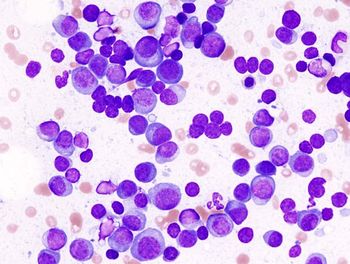
Cohort Study Identified Optimal Minimum Treatment Duration for ADT in High-Risk Prostate Cancer
Patients with high-risk prostate cancer appeared to derive benefit from androgen deprivation therapy given for a minimal duration of over 18 months plus external beam radiotherapy.
A cohort study found that the optimal minimum duration for androgen deprivation therapy (ADT) plus high-dose external beam radiotherapy (EBRT) was more than 18 months for a significant impact in patients with high-risk prostate cancer. However, EBRT plus brachytherapy was found to yield benefit at 18 months or less, according to a study published in JAMA Oncology.
A total of 2935 patients were included in the study population from 3 different cohort studies. The minimum duration of thresholds found through a cubic spline analysis was 26.3 months (95% CI, 25.4-36.0) for EBRT and 12 months (95% CI, 4.9-36.0) for EBRT plus brachytherapy to have an improved effect on distant metastases-free survival (DMFS). The phase 3 RADAR study (NCT00193856) found patients who were treated with ADT plus EBRT for a prolonged period did not have significant improvements in DMFS (HR, 1.01; 95% CI, 0.65-1.57), but those who received EBRT plus brachytherapy had improved DMFS (HR, 0.56; 95% CI, 0.36-0.87; P = .01). Additionally, for those in the phase 3 DART study (NCT02175212) for patients with high-risk prostate cancer, EBRT was given alone followed by 28 months of ADT, which was associated with an improvement in DMFS vs 18 months in the RADAR trial (HR, 0.37; 95% CI, 0.17-0.80; P = .01).
Examining OS and DMFS in the Retrospective Cohort
The median follow-up was 6.4 years for those who received EBRT and 7.1 for EBERT plus brachytherapy. Of the patients who were treated with EBRT and 6 to 18 months of ADT, DMFS was not a significant factor (HR, 0.90; 95% CI, 0.61-1.31; P = .58) or overall survival (OS; HR, 0.90; 95% CI, 0.58-1.38; P = .62). Among patients treated with EBRT, treatment with ADT for 6 to less than 18 months was not associated with DMFS (HR, .90; 95% CI, 0.61-1.31; P = .58) or OS (HR, .90; 95% CI, 0.58-1.38; P = .62) vs less than 6 months of ADT. However, treatment with ADT for 18 months or more was associated with improvements in DMFS (HR, 0.44; 95% CI, 0.31-0.63; P <.001) and OS (HR, 0.45; 95% CI, 0.30-0.68; P <.001) compared with treatment for less than 6 months (DMFS: HR, 0.49; 95% CI, 0.39-0.62; P <.001; OS: HR, 0.50; 95% CI, 0.39-0.65; P <.001) and 6 to less than 18 months (DMFS: HR, 0.49; 95% CI, 0.39-0.62; P <.001; OS: HR, 0.50; 95% CI, 0.39-0.65).
Of those who received ADT from 6 to less than 18 months as well as EBRT plus brachytherapy, investigators identified an association with improved DMFS (HR, 0.34; 95% CI, 0.25-0.45; P <.001) and OS (HR, 0.30; 95% CI, 0.22-0.41; P <.001) vs less than 6 months of ADT. Improved DMFS (HR, 0.42; 95% CI, 0.32-0.54; P <.001) and OS (HR, 0.43; 95% CI, 0.33-0.56; P <.001) were associated with ADT for 18 months or more in those who received EBRT and brachytherapy. This analysis did not detect any association between receipt of ADT for 18 months or more and improved DMFS vs 6 to less than 18 months of treatment (HR, 1.23; 95% CI, 0.91-1.66; P = .17). Moreover, a longer duration of treatment with ADT was associated with lower OS (HR, 1.44; 95% CI, 1.04-1.99; P = .03).
Comparing the Retrospective Cohort With the RADAR Cohort
Investigators hypothesized that increasing ADT from 6 to 18 months would show an improved DMFS benefit for those who received EBRT plus brachytherapy but not EBRT alone. Patients received 74 Gy EBRT or EBRT plus radiotherapy. The median follow-up was 10 years for EBRT and 11 years for EBRT plus brachytherapy. Overall There was no association with significant improvement in DMFS (HR, 0.75; 95% CI, 0.55-1.02; P = .07) or OS (HR, 0.75; 95% CI, 0.52-1.06; P = .11) for those who were given ADT of 18 vs 6 months.
Examining the RADAR and DART Cohorts
For this cohort, investigators believed that giving ADT for more than 18 months would improve DMFS and OS among those receiving a high dose of EBRT. A metanalusis was conducted comparing 28 months of ADT in the DART cohort to 6 or 18 months of ADT in the RADAR cohort.
Twenty-eight months of treatment with ADT was associated with improved OS (HR, 0.30; 95% CI, 0.10-0.88; P = .03) vs the 6 month cohort. Additionally, 28 months of treatment with ADT was associated with improved DMFS (HR, 0.37; 95% CI, 0.17-0.80; P = .01) and OS (HR, 0.34; 95% CI, 0.12-0.99; P = .049) compared with 18 months of treatment.
At 5-years, the adjusted DMFS rates for those receiving high dose EBRT were 93.5% (95% CI, 87.9%-99.1%) for 28 months of ADT vs 76.7% (95% CI, 68.1%-85.3%) with 18 months vs 79.6% (95% CI, 70.8%-88.3%) with 6 months. For OS, the 5-year adjusted rates were 96.0% (95% CI, 91.5%-100.0%) with 28 months of ADT vs 87.3% (95% CI, 80.5%-94.0%) with 18 months vs 90.6% (95% CI, 84.2%-96.9%) with 6 months.
Reference
Kishan AU, Steigler A, Denham JW, et al. Interplay between duration of androgen deprivation therapy and external beam radiotherapy with or without a brachytherapy boost for optimal treatment of high-risk prostate cancer: a patient-level data analysis of 3 cohorts. JAMA Oncol. 2022;8(3):e216871. doi:10.1001/jamaoncol.2021.6871
Newsletter
Stay up to date on recent advances in the multidisciplinary approach to cancer.

















































































